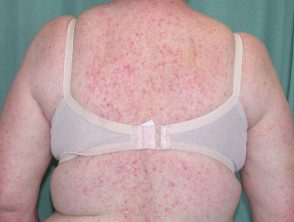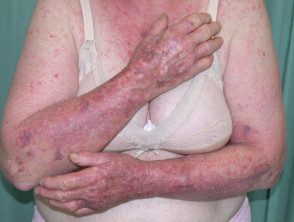Introduction
Most adverse cutaneous the events associated with vaccines are caused by a normal inflammatory response to a foreign substance. Since these inflammatory reactions are not related to allergy, most patients can safely receive subsequent vaccinations. A less common cause of an adverse skin reaction is an allergy to a vaccine or one of its components.
Inflammatory skin reactions.
| Vaccination/Constitution | Reaction | Why |
|---|---|---|
| Most vaccines | Local reactions at the injection site, such as swelling, redness, and / or pain can occur with up to 80% of vaccine doses, depending on the type of vaccine. Local reactions generally occur within a few hours of the injection, are generally mild, and do not require any specific treatment. | The normal inflammatory response to a foreign substance. |
| Measles, Mumps, and Rubella (MMR) Vaccine | Transient eruption in up to 5% of the recipients. | Since the vaccine contains live viruses, it is probably due to the modified measles induced by the vaccine. |
| Chickenpox vaccine |
Chickenpox lesions can appear at the injection site in approximately 3% of recipients. In another 3%, the lesions may be more generalized. A zoster-like rash can rarely appear after the chickenpox vaccine. |
Another live virus vaccine that can cause vaccine-induced illness. |
| Tetanus and diphtheria toxoids | Hypersensitivity (sometimes called Arthus-type reaction): rare and severe local reaction (swelling, redness, pain). Not allergic | It is believed to be due to the very high concentration of antibody, usually caused by too many doses of toxoid. |
| Aluminum hydroxide | Induces subcutaneous nodules (small lumps under the skin) in up to 19% of patients. The nodules usually resolve within a few months. Not allergic | Non-specific reaction to a foreign substance. |
| Tetanus and diphtheria toxoids | Generalized urticaria (urticaria), angioedema, and unidentified eruptions in about 5 to 13% of the recipients. | Studies suggest that most mild to moderate generalized reactions result from nonspecific activation of the inflammatory system by high doses of bacterial components. Subsequent booster injections of suspect vaccines are well tolerated. |
Allergic reactions
Allergic contact dermatitis
Located Allergic contact dermatitis can be induced by the components of the vaccine. Historically, dermatitis was due to neomycin and thiomersal. Thiomersal is no longer present in vaccines in New Zealand, but may be used in some vaccines elsewhere.
Contact allergy is confirmed by patch tests using potential Allergens in the vaccine
Dermatitis after the flu shot.

Dermatitis after the flu shot.

Dermatitis after the flu shot.
The previous patient had long-standing hand dermatitis and developed severe generalized dermatitis shortly after her first flu shot.
Anaphylaxis
Anaphylaxis is a severe allergic reaction that occurs at a rate of about 1 per million vaccine doses. The allergic reaction can be caused by the vaccine. antigen itself or some other component of the vaccine, such as animal protein, antibiotic, preservative or stabilizer; gelatin, egg, chicken, and / or yeast are commonly implicated.
Anaphylactic Reactions generally occur within 4 hours of receiving the vaccine and involve multiple body systems, with generalized urticaria (urticaria), angioedema, shortness of breath, and low blood pressure. Severe anaphylaxis can be fatal. If an anaphylactic reaction occurs, immediate resuscitation is required (see ASCIA Anaphylaxis Action Plan). Later, allergy testing (under careful medical supervision) is recommended and no additional doses of the vaccine should be given. A blood test called RAST or EAST can be used to exclude an egg allergy.
Drug-induced urticaria without anaphylaxis can also be the result of vaccines.
Erythema multiform
Erythema multiforme is occasionally caused by vaccines. Erythema multiforme is characterized by the objective or Diana hand, foot and leg injuries. It has been reported after mumps / measles / rubella, diphtheria / pertussis / tetanus, hepatitis A / B, human papillomavirus (genital wart vaccine) and meningitis vaccinations
Stevens-Johnson syndrome / / toxic epidermal Necrolysis has also been rarely reported to follow vaccination. This is a potentially very serious condition in which the skin and mucous The membranes blister and erode.
Viral infection
Vaccines are intended to prevent viral disease. However, patients who are on immunosuppressive therapy should avoid live vaccines in case the vaccine causes extended viral disease. For example, the vaccine against Herpes zoster it is contraindicated in these patients due to the risk of disseminated herpes zoster infection, which can be fatal.

